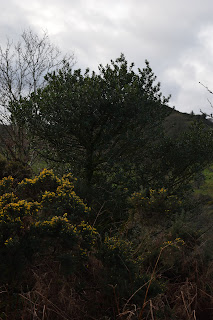When is a wood not a wood? When it is poor scrubland
Bel’s Wood is currently poor scrubland that has been grazed in the past with cattle and sheep. Deer are present on the land too so new trees may struggle to become established.

Silver birch dominate along the stream and appear to be of similar age and maturity. Hawthorn is well established. There are some enormous holly trees.
Gorse dominates with bracken in between. It is a pleasure to walk around the site in winter with the bracken lying on the ground. The gorse is 3-4m high in places. Deer clearly manage to find ways through. The more I look the more I see that there are trees becoming established in the thick gorse areas. Mostly hawthorn but also some broom. The theory is that gorse and bramble are nature’s barbed wire and allow seedlings to become established. As these mature they will starve the areas below of light and the bracken and gorse will die back.
One of the many dilemmas I am grappling with is how much to interfere & actively manage the land. Rewilding Britain recommend allowing seeds to flourish to establish a woodland and only interfere and help should that be necessary. Planting new trees should only occur when there is no seed stock in the soil. This slower more natural approach means that the seeds are local and likely to thrive.
‘Letting trees and shrubs naturally regrow over much of their former landscapes – with a helping hand where needed, such as preparing the ground when necessary or sowing tree seeds when naturally available seed sources are too far away – would create woodlands better able than plantations to soak up carbon dioxide, support wildlife, and adapt to a changing climate. Costs and management, imported tree diseases, and plastic tree guards would all be reduced.’ https://www.rewildingbritain.org.uk/blog/press-release-natural-regeneration-key-to-doubling-woodlands-and-saving-britains-crippled-forests
My motivation to plant trees is to increase carbon capture and to support biodiversity. For example: more trees generally on this land would be good and to encourage red squirrels to thrive here, more conifers would be helpful eg Larch and Scots Pines. These are not currently growing on the site or in neighbouring areas so would need to be introduced. Removing gorse to encourage a more rapid establishment of woodland may result in greater biodiversity but deliver little or no improvement in carbon capture as one type of tree would be replaced with another.
Happily no urgent decisions need to be made. A respite from grazing has only begun with the erection of fences and gates in the last month and this will mean that this is the first spring where the land can respond naturally. My job remains to watch and learn over this coming year as the seasons unfold.











You're starting to sound like a proto-expert on woodlands. Great stuff!
ReplyDeleteConsciously incompetent - it's a start! (rather than unconsciously incompetent!)
Delete